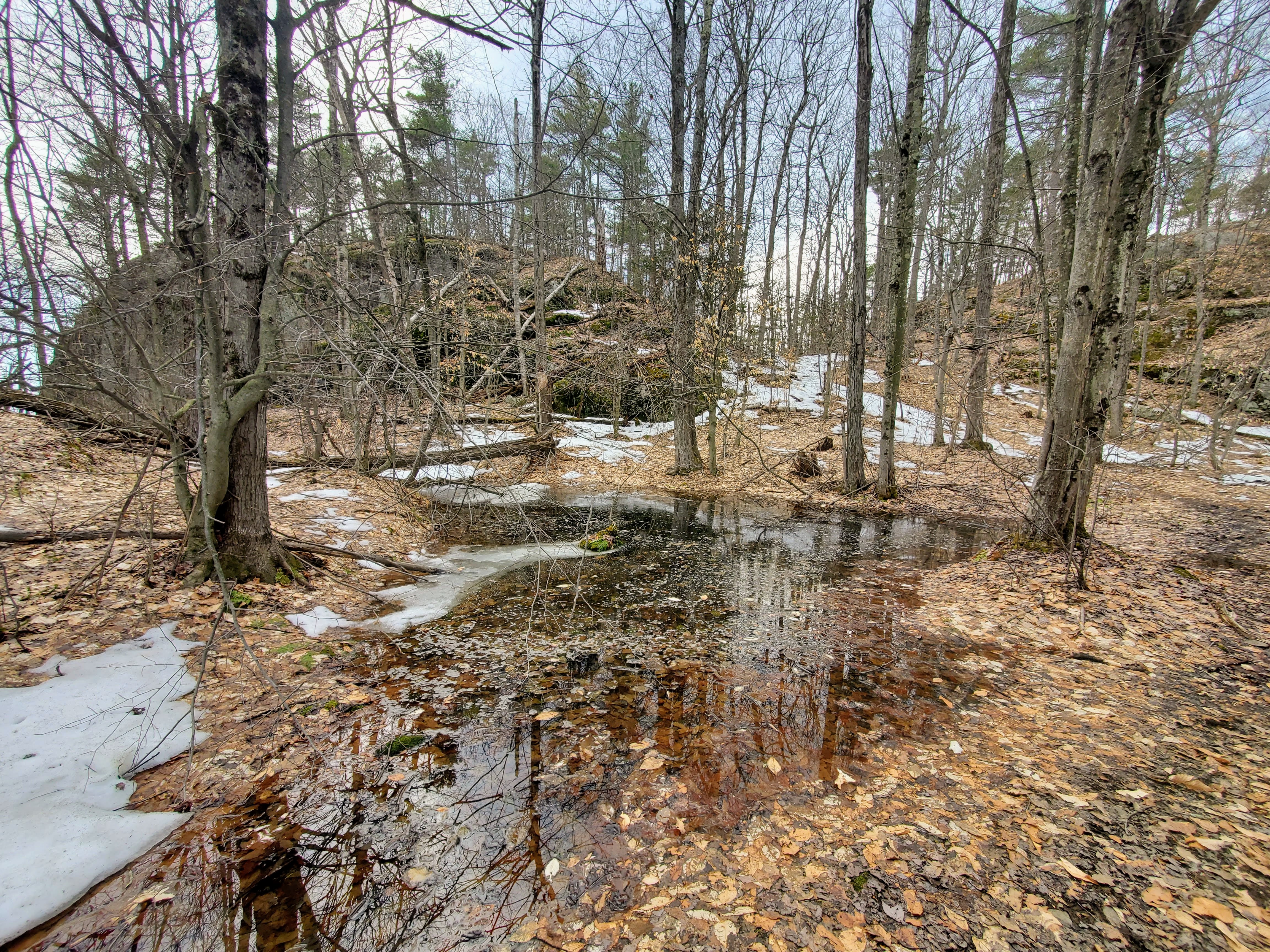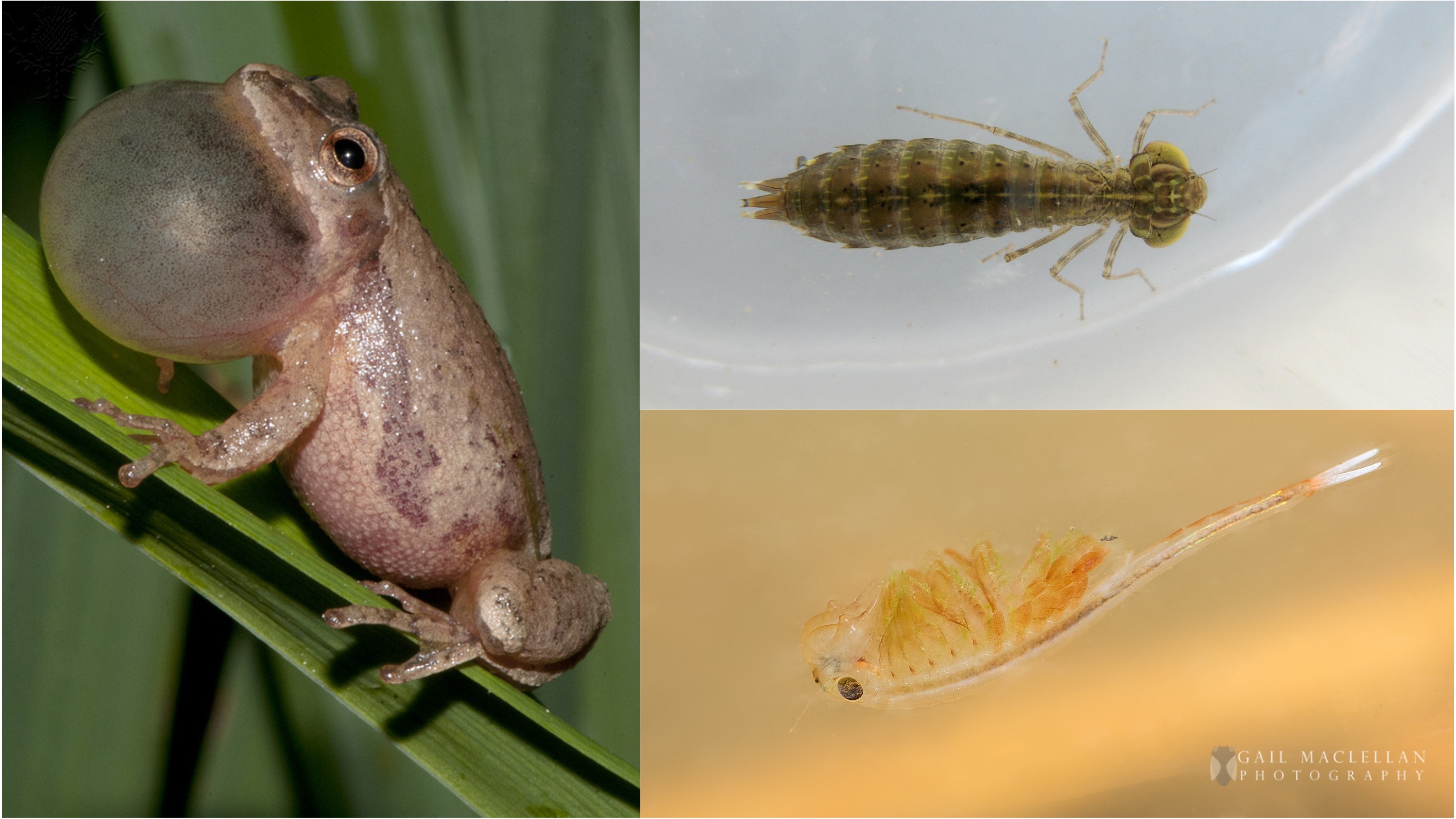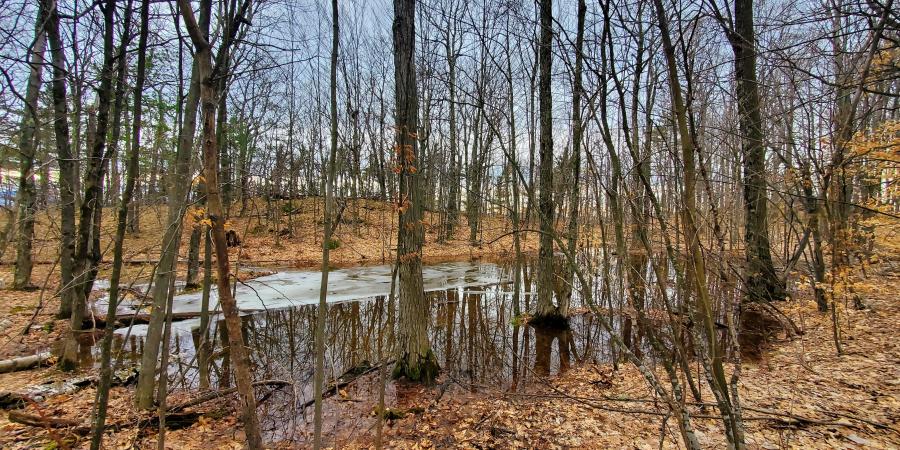On a rainy spring night, have you ever noticed a lot of frogs or salamanders on the road and wondered why they are there? These amphibians aren't just out enjoying the night. They are looking for somewhere to mate. Unfortunately, because of habitat fragmentation, this journey has become more dangerous, often taking them across roads. While some amphibians stay in or close to water, others spend the majority of their time in forests, but they still need waterbodies for breeding. When spring comes, many make the journey to streams, ponds, and adjacent wetlands, while others venture to more isolated vernal pools to mate.
What are vernal pools?
Vernal pools are wetlands that are only wet part of the year. They are typically small, shallow depressions in the forest floor with an impermeable layer of leaf litter, clay, or bedrock that keeps water from draining. Vernal pools are not connected to or fed by permanent streams, springs, or other waterbodies. Their water comes from snow melt and rain. Vernal pools are wet during the winter and spring and dry out by late summer or fall. This is why these pools are described as vernal, which means "in, or appropriate to spring," hence the vernal equinox. The amount of time vernal pools are wet differs from pool to pool and year to year, depending on weather conditions.

A vernal pool along a trail in the Boquet River watershed.
What animals use vernal pools?
Despite being wet only part of the year, vernal pools provide important habitat for many amphibians and invertebrates. Because the pools dry out, they cannot sustain fish populations. This means that other species can reproduce without the risk of predation by fish. Many amphibians take advantage of this safety and use vernal pools as their breeding habitats. Salamanders and frogs lay their eggs early in the spring, giving their young enough time to develop into immature land-dwelling adults by the time the pools dry out. Spotted salamanders, Eastern newts, wood frogs, and spring peepers are just a few of the amphibians that use vernal pools.
Many invertebrates also call these wetlands home. Aquatic insects, crustaceans, and mollusks often spend their entire lives in vernal pools, adapting to the dry conditions when they come. Dragonfly and damselfly nymphs are some of the top predators in vernal pools; they survive when the pools dry out by finding moist areas under rocks or burrowing down into the soil.

A few animals that use vernal pools: spring peeper (left), dragonfly nymph (top right), and fairy shrimp (bottom right). Photos by Reni Akande, Dave Huth, Gail MacLellan.
Fairy shrimp are crustaceans found only in vernal pools. Their short lifecycle is well suited to these environments. They hatch in late winter or early spring before their predators are active. Sometimes they can even be seen swimming under the ice. Fairy shrimp produce two types of eggs. Their summer eggs hatch quickly and develop into adults within a couple of weeks. The winter eggs are hard-shelled and fall to the bottom of the pool. They remain there after the pool dries out and throughout the winter, able to withstand both drying and freezing. Once the pool refills the next year, these eggs hatch. Other invertebrates also lay eggs that lay dormant until the next spring on the bottom of pools.
While some animals live in vernal pools or use them for breeding, many others use these habitats for feeding or foraging. Turtles come to feed on egg masses, while snakes and raccoons prey upon tadpoles and frogs. Some birds will also visit to find food. Vernal pools may be small and dry out during the year, but their ecosystems are complex.
Support our biodiverse habitats work for wildlife and their habitats. Give with confidence today!
Threats to vernal pools
Before we learned the value of wetlands, we lost many to filling and draining. Almost half of New York's historic wetlands were lost before regulations were put in place to protect them. In 1975, New York passed the Freshwater Wetlands Act to preserve, protect, and conserve wetlands across the state. While the Department of Environmental Conservation is responsible for administering this act in the rest of the state, the Adirondack Park Agency oversees wetlands regulations within the Adirondack Park. Wetlands within the park are further regulated under the Adirondack Park Agency Act, which defines a wetland as "any land which is annually subject to periodic or continual inundation by water and commonly referred to as a bog, swamp or marsh which are either (a) one acre or more in size or (b) located adjacent to a body of water, including a permanent stream, with which there is free interchange of water at the surface, in which case there is no size limitation." Many vernal pools do not meet this definition of a wetland.
Because of their small size (often less than an acre) and isolation (not connected to a permanent stream), vernal pools are not always identified or mapped as wetlands or given the same protections as other wetlands. This leaves them vulnerable to disturbance and destruction. Many vernal pools have been lost because of human activities, and others continue to be threatened today. They are filled in, deepened into fish or retention ponds, destroyed during logging, altered through changes to hydrology, such as ditching, or otherwise disturbed by human development. This means a loss of habitat and sometimes the loss of entire populations of the species that rely on these ephemeral water bodies.
As the climate changes, vernal pools may be even more threatened. Change in precipitation amounts, temperatures, and evapotranspiration rates (the process by which water moves from the land to the atmosphere through evaporation from the soil and other surfaces and transpiration from plants) will all affect the amount of time vernal pools remain wet. Both longer and shorter wet periods can dramatically affect which species can survive in these ecosystems.
It is important that we work to protect these habitats before they are lost. In areas with a lot of private land, stewardship by landowners is critical. Many people are unaware that vernal pools exist on their property and inadvertently damage them. If you are a landowner, search your property in the spring to see if you spot a pool in the woods or hear a symphony of frogs. Stop and explore it. While it may look like a puddle, it could be teeming with life.
Story by Liz Metzger, Research Associate.
Sign-up for our e-newsletter to get weekly updates on the latest stories from the Ausable River Association.


